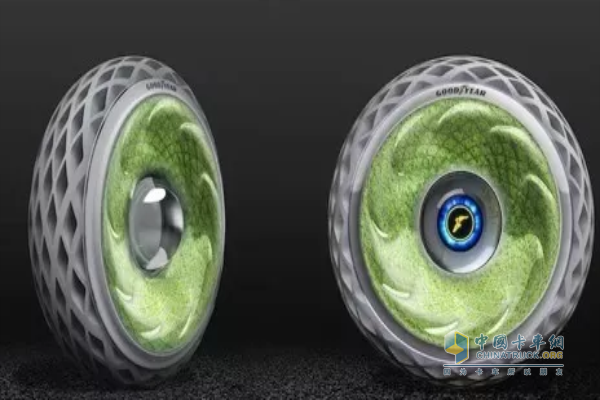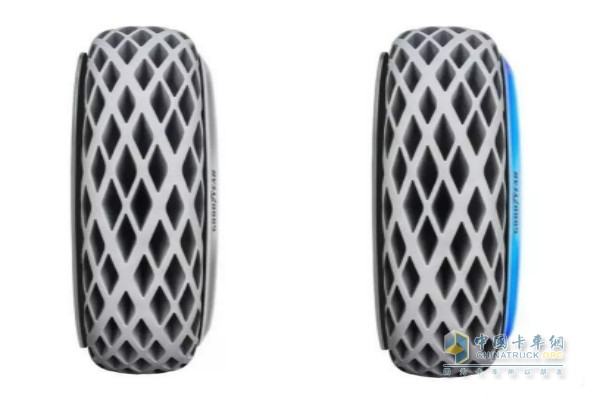A few days ago, Goodyear's latest concept tire Oxygene debuted at the Geneva International Motor Show in 2018. This concept tire has a unique structure, the biggest highlight is the live moss growing in the tire wall. The unique tread design combined with this open structure allows the tire to absorb and circulate water from the road surface, thereby allowing the moss to produce photosynthesis and releasing oxygen into the air.
 Goodyear's latest concept tire Oxygene
Goodyear's latest concept tire Oxygene According to the statistics of the World Health Organization (WHO), in urban areas with air pollution monitoring, more than 80% of the population lives in polluted environments where the air quality is lower than the World Health Organization (WHO) limits. Inspired by the principle of circular economy, Goodyear's Oxygene concept tires will focus more on reducing the waste of raw materials, reducing harmful emissions and avoiding energy losses, and provide the following performance solutions.
Clean Air: The Oxygene concept tire absorbs moisture from the road through a specially designed tread and inhales carbon dioxide in the air and feeds it to the moss in the tire wall. Eventually, oxygen is released through the photosynthesis of the plant. This means that in a city comparable to Paris and with approximately 2.5 million cars, it will generate nearly 3,000 tons of oxygen per year and absorb more than 4,000 tons of carbon dioxide.
Recycling of worn tires: The Oxygene Concept Tire achieves an inflation-free tire construction using 3D printing technology. Its raw materials consist of rubber powder made from recycled old tires. The lightweight, shock-absorbing structure provides anti-puncture and ultra-durable tire solutions that extend tire life, minimize maintenance issues, and provide a carefree travel mode. The open structure of this tire helps the tread absorb moisture from the ground and at the same time improves the grip on wet road conditions, thus ensuring the safety of travel.
Self-Generating: The Oxygene concept tire collects energy generated during photosynthesis and powers the tire's embedded electronics, including in-tire sensors, artificial intelligence processing components, and customizable light bands in the tire walls. The band can change colors to alert drivers and pedestrians of upcoming movement alerts, such as changing lanes or braking.
Light speed communications: Oxygene concept tires use a visible optical communication system, or LiFi, to achieve high-capacity light-speed mobile connectivity. LiFi can connect tires to the Internet of Things, enabling data exchange between vehicle-to-vehicle (V2V) and vehicle-to-vehicle infrastructure (V2I), which is critical for smart travel management systems.
 Goodyear's latest concept tire Oxygene
Goodyear's latest concept tire Oxygene
Chris Delaney, president of Goodyear Europe, Middle East and Africa, said: "As with Goodyear's conceptual design exhibited at the previous Geneva Motor Show, Oxygene concept tires mean challenging our past ways of thinking and focusing on intelligence, safety and Continuing the future to explore the imagination. By bringing cleaner air in this way, this tire will help improve the quality of life and health of urban residents."
Readings:
Tungsten carbide pellets are small, cylindrical or spherical shapes made from tungsten carbide, a hard and dense material. These pellets are typically used in various industrial applications, such as drilling, grinding, cutting, and wear-resistant components.
Tungsten carbide is a compound of tungsten and carbon, known for its high hardness, strength, and resistance to wear and corrosion. It is often used as a cutting tool material, as well as in the production of mining and drilling equipment.
The pellets are usually produced through a process called powder metallurgy, where Tungsten Carbide Powder is mixed with a binder material and then compacted under high pressure. The compacted pellets are then sintered at high temperatures to form a solid and durable product.
Tungsten carbide pellets are used in various industries, including mining, construction, oil and gas, and manufacturing. They are commonly used as inserts in drilling bits, cutting tools, and wear-resistant parts, providing high performance and extended tool life.
Overall, tungsten carbide pellets are essential components in many industrial applications, offering superior hardness, strength, and wear resistance.
Carbide Pellets,Cemented Carbide Pellets,Tungsten Carbide Pellets,Tungsten Carbide Alloy Pellet
Luoyang Golden Egret Geotools Co., Ltd , https://www.xtcmetalpowder.com